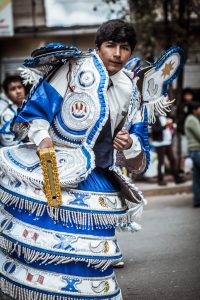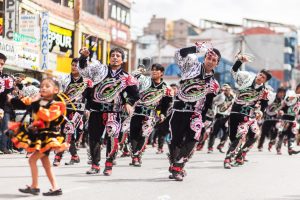The Telling Oddity of Morenada in Cuzco

It’s Sunday morning and I am sitting above Cuzco’s main plaza, writing. Since it is also June, the cacophony of bands who accompany different dance troupes sounds all around. But I focus on my writing, until the pulse of something familiar from elsewhere pulls me from my chair to the balcony.
Below me women with derby hats are slowly turning from one side and then to the other. Their broad, pleated, skirts–all of the same color–fan out and then retract, only to fan again.
Suddenly, I was transported to Copacabana, Bolivia during the feast of the Virgin of Candelaria. I stood on a small balcony three stories above the plaza and saw the appearance and disappearance of this bright circle. I also remember a time when I was in a high rise above La Paz, Bolivia’s main street the 16 de Julio and saw a similar unfolding and folding.
These skirts belong to the women of a bloque (block) of dancers performing the famous Morenada, perhaps the most popular dance of the Altiplano, the high plateau around Lake Titicaca. The Morenada is widely said to honor African slaves who came with the Spanish and stepped on grapes to make wine, although I think a truer argument historically would say it represents the mountain Gods (ancestors) coming into town and that it originated on Lake Titicaca instead of in the grape growing valleys of Potosi and Sucre in Bolivia.
In any case, over the last sixty years the Morenada has become the most widely performed dance on the Altiplano and is now claiming place in Cuzco.


Seeing the women with their broad skirts and typical hats spinning one way and then another in Cuzco, as well as the men in the wide, layered costumes, with plumes rising from their heads as if a bunch of paja brava, the tough grass characterizing the Altiplano, makes my spine tingle with their majesty and power.
At the same time, I recognize the similarity and difference from all the other dance troupes that are more typical of Cuzco performing around me.
For some reason, best left to ethnohistorians and folklorists, the people of the Altiplano are like a pepper spicing up the numerous dances that represent Cuzco. You will see one version or another of the people of the Altiplano, called Collas.
Often, they are represented as llama herders in a dance called Jatun Colla. Now the Morenada appears, but it is different. From what I am told, mostly people from the Altiplano dance it.
However, I do not know if that is true. Like so many other things, it may simply reproduce the image of the exotic all the while many people from Cuzco are actually donning these skirts and masks of the foreign other.

In any case, the Morenada marks a strong incursion of Altiplano culture and people into Cuzco. Some people feel that incursion threatens the integrity of Cuzco’s own self representation. In contrast, dances such as Jatun Colla safely domesticate the Colla into graspable terms and images while the Morenada feels inevitably foreign. I am told that there have been official efforts recently to ban the Altiplano dances from being performed in iconic Cuzco celebrations such as Corpus Christi.
In this sense it is worth mentioning the other controversy over whether one can even call the Morenada Peruvian. Peru vigorously insists they are part of Peruvian patrimony, since they are widely and historically performed in Puno, its Altiplano department.
However, the neighboring country of Bolivia insists the dance belongs to them and their national culture. Because of this connection to Bolivia, and the Altiplano, Puno often feels exotic and slightly foreign to many Peruvians.
More than just being close to Bolivia, Puno has a large percentage of its population who are Aymara. In Peru’s press the Aymara are written about as strange and almost wild in their incomprehensibility to the coastal peoples.

But there is probably more. Cuzco has a strong system of feasts organized by neighborhoods and social organizations (such as fraternities, businesses, schools, markets, and labor organizations). These are connected with the images of Cuzco’s saints and its parishes. Through feast sponsorship, called here jurqa, the society is unified. People are either supporting friends and family who are sponsoring feasts or sponsoring feasts themselves. In this way the private networks of Cuzco society, friendship and kinship, are drawn into the whirl of festive activity that composes the whole.
A municipal organization further coordinates all this activity, religious and social, in order to present it all around the Plaza at the appropriate time and place. Called EMUFEC, this body is responsible for organizing and promoting festivities.
In contrast, on the Bolivian Altiplano the dance troupes appearing in feasts are increasingly much less tied to governmental, neighborhood, and religious organization, even when they perform during official feasts. They are intriguingly entrepreneurial and connected with the need to create alliances, social and economic ties, in urban areas to which people have immigrated and, as a result, are not from.
Like Pentecostal congregations, they flourish among immigrants and informality, for whom they provide ties, social and economic opportunity, as well as meaning.
Yet, the system of Cuzco is set up to avoid this informality and to present something aesthetically and socially pleasing that can represent the city of Cuzco as a whole.

After writing the above I went down and spoke with some of the dancers. The troupes were dancing in devotion Cuzco’s Virgin of the Nativity of Almudena. Some of the dancers said that they represented a fraternity of people from Puno who had migrated to Cuzco and were living here, others said they were from Cuzco and had been dancing Morenada since they were children in devotion to the Virgin because it was the custom and culture of Cuzco. These latter belonged to a fraternity they said was named the Intocables (the Untouchables).
I also asked one of the bands, the Wiraj’ochas, where they were from and they said Puno.
Thus, while the altiplano dances are tied into EMUFEC’s system, by dancing in the procession of the Virgin of the Nativity they still seem to me to suggest a different social order and reality.
Whether that of the kind of entrepreneurial formation of dance troupes as an economic and social strategy in new circumstances–immigration, or as an incursion of a culture from a different area into Cuzco, the Morenada suggests to me something Cuzco’s society and elite struggle to avoid in their celebration of their Inca past and current social and cultural order.
One more point. I am told that another dance from Bolivia (the Afro Bolivian Saya) has strong roots in Cuzco. Young people from Cuzco organize dance groups in order to compete in festivals locally and nationally.
While still from the neighboring space of what once was Collasuyo, the Saya has spread in Cuzco, I think, mostly as a result of commercial promotion and the development of festivals. As a result, it is different from the Morenada which is brought in the feet and hearts of people from Puno who migrate to Cuzco where it has now taken root in their organizations which are integrating into Cuzco’s society, even while seeming different.




